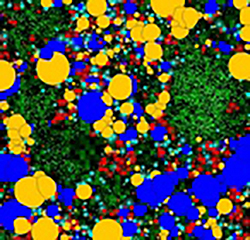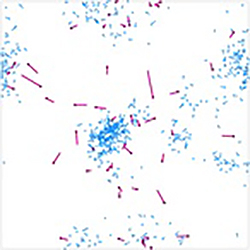Mathematical modelling and simulation play an important role in acquiring a detailed understanding of complex ecological and social-ecological systems. This includes the analysis of specific characteristics and driving processes, the application to hypothetical situations (scenarios) and the extrapolation for potential future situations. The working group focuses on the analysis of actors' reactions to environmental situations and interaction with other actors in a spatial context. A sufficiently detailed description of an actor allows to determine how their behaviour and development affects the self-organisation and the emergence of community structure and dynamics within a given (eco)system.
The methodological focus of the work group is on individual/agent-based modelling (IBM/ABM) which simulates the global characteristics of dynamic systems on the basis of interacting system components. IBM offer a structurally unique approach in ecology which promotes linking quantitative and qualitative aspects across different hierarchical levels. The use of IBM as an integrative modelling framework thus has the potential to address a large number of questions that have not been accessible to the same extent before.
Example Projects:
1) Modelling Spatial
Interactions and Competition in Coral Reefs
A detailed representation of competition processes in coral reefs has been developed using a spatially explicit agent-based modelling approach. The model includes benthic processes as well as food web interactions and due to its modular approach additional components are being added repeatedly. The model has been used to analyse scenarios of reef composition (coral traits), disturbance regions and temperature rise (e.g. Kubicek et al. 2012, 2019) and it is basis for several BSc and MSc Theses. Furthermore the model has been integrated into a highly immersive and interactive virtual 3-D representation of reefs which allows users to directly control the scientific simulation and directly experience the outcomes of different scenarios (in cooperation with Computer Graphics and Virtual Reality, Uni Bremen). A further model stresses different use scenarios on Indonesian coral ecosystems (Minarro et al. 2018) .
Handling Biodiversity Data
The Project NeDiT (New Digital Technologies for Marine Biodiversity Data Handling in East Africa – Data Linking People) started in end of 2018 (in cooperation with the Institute of Marine Sciences Zanzibar, fundet by GIZ). It targets the necessity of a rapid communication, integration of different data bases and analyses of marine data between relevant actors, such as governmental administration and research institutes to achieve a science-based management of marine biodiversity and natural resources. With these aims the project has a high policy relevance and a very high international cooperation potential and includes cooperation with high-level regional actors such as WIOMSA and UNEP Nairobi Convention.
Seagrass Reaction to changing environmental conditions
The overarching goal of the SEANARIOS project aims at anticipating seagrass reactions to elevated temperatures and increased nutrient levels thereby identifying early warning signals for threatening changes. The project is part of the German-Israeli Cooperation in Marine Research (WTZ Israel funded by BMBF) with G. Winters (Dead Sea-Arava Science Center) a further Italian partner (G. Procaccini, Stazione Zoologica Napoli). The project consists of an experimental part led by the ZMT's WG Algae and Seagrass Ecology and a modelling part conducted by the WG Spatial Ecology and Interactions. More information on the current phase of WTZ Israel (only in German) here: https://www.fona.de/de/deutsch-israelische-zusammenarbeit-in-der-meeresforschung-20646.html
Further topics
In addition the work group addresses further topics with specific model applications such social-ecological implications of resource use in coastal regions, connectivity of coastal habitats and spatial as well as temporal self-organisation of food-webs depending on organismic traits. With respect to modelling theory we address questions related to validation of IBM/ABM and on teaching and capacity building in ecological modelling (e.g. the text book Modelling Complex Ecological Dynamics, Springer 2011). In cooperation with the Biological Lab of ZMT (Achim Meyer) we analyse population structure of reef fish in East Africa and of marine turtles in Indonesia.







